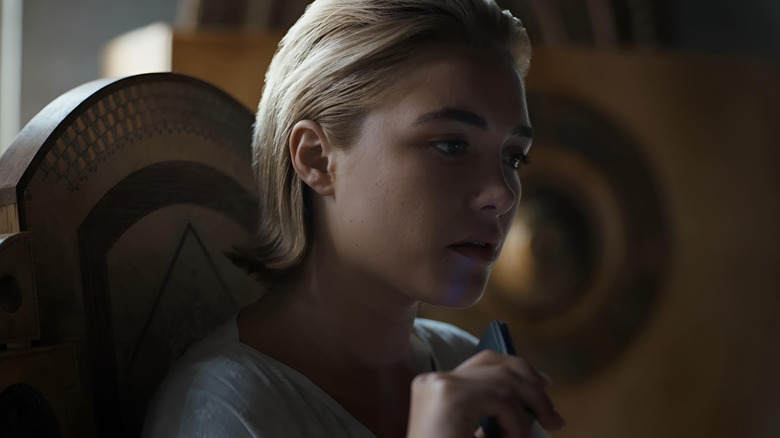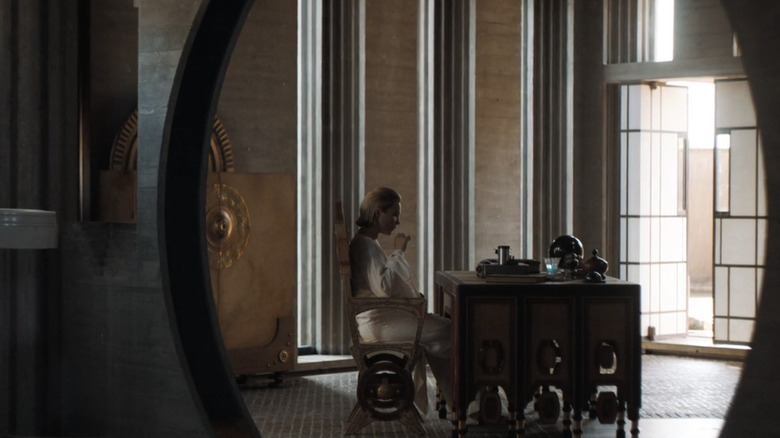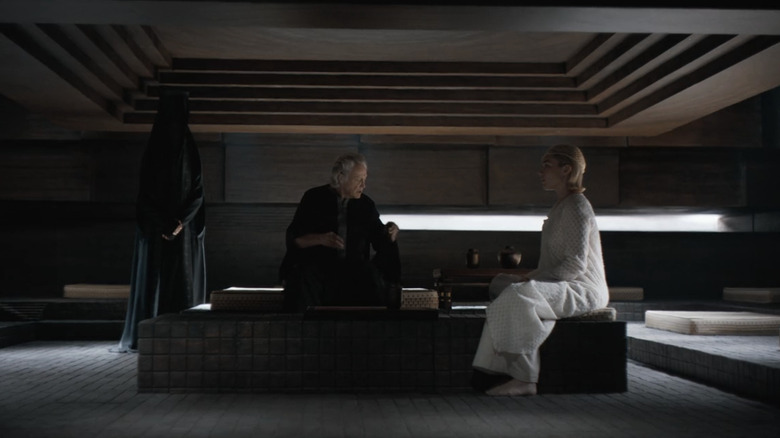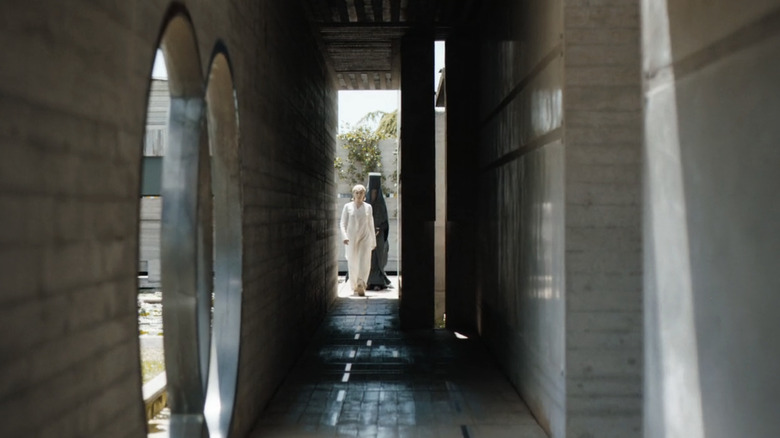How Dune 2 Shot In An Italian Sanctuary Where No Movie Was Allowed Before
Before director Denis Villeneuve and production designer Patrice Vermette put their talents to work, "Dune" and "Dune: Part Two" were in danger of being a tad visually monotonous. With the first film in particular, there's only so much you can do aesthetically with a movie that takes place entirely on an arid, desert planet. Still, we did get a look at the Atreides' native planet of Caladan at the top of "Dune," which provided a nice counterpoint to the sepia hues that dominated the rest of the film. For the sequel however, Villeneuve not only ratcheted up the action, but gave us even more of a visual feast.
While "Dune: Part Two" was still somewhat of a bleak blockbuster, most of the gloominess came from the film's finale, in which Paul Atreides (Timothée Chalamet) embraces his ascension to the Emperor's throne and dismisses his true love, Chani (Zendaya), in the process. It serves as a grim statement on the fallacy of a belief in messiahs, with Paul ordering his Fremen troops into battle against the great houses as the film closes.
Otherwise, though, "Dune: Part Two" was much more diverse visually than its predecessor, giving us our first glimpse of Geidi Prime exteriors, which were all shot in infra-red to create a ghostly monochrome aesthetic, complete with influence from "Nosferatu." The sequel also introduces new design languages to Villeneuve's duology. When Emperor Shaddam IV (Christopher Walken) touches down on Arrakis, for example, his "Emperor's tent" takes up residence on the barren Arrakis plains, sporting a design that was inspired by Rolex watches.
With "Part Two," we also got some brief glimpses of yet another planet in the Dune universe: the Imperial planet of Kaitain. For scenes set on the Emperor's homeworld, Villeneuve and his crew were granted access to a previously off-limits Italian sanctuary.
The Dune films meld fabricated and real-life locations
There's no doubt that "Dune" and its sequel are technical marvels. The "Dune" visual effects team won an Oscar for their work creating a real sense of scale on the first film, with the VFX artists managing to meld their digital work with Patrice Vermette and his team's practical effects to create a seamless blending of CGI and practical cinematography that David Fincher would be proud of. Meanwhile, cinematographer Greig Fraser conducted a symphony of perfectly-composed shots and finely-tuned lighting effects, while Vermette ensured every single sand dune was the perfect shape, color, and consistency for the moment in question.
Vermette also excelled with his designs for the elements that couldn't be found naturally in the deserts of Jordan and Abu Dhabi. Aside from the aforementioned Rolex watch influence, the production designer drew from a multitude of sources to create distinct looks for each location shown in the films. In "Part Two," the landscapes of the Harkonnen homeworld of Geidi Prime were conceived with septic tank design in mind. But when it came to Emperor Shaddam's Imperial headquarters, Denis Villeneuve and his production designer had to look further afield.
In the book "The Art and Soul of Dune: Part Two," authors Tanya Lapointe and Stefanie Broos recount how "Part Two" begins on Kaitain, with Princess Irulan (Florence Pugh) recounting the events of the previous film and expanding on the behind-the-scenes machinations that motivated them. The authors explain how the script "called for a 'lush Imperial garden,'" as the setting for Irulan's introduction, which "initiated a worldwide search for locations that would fit this description but also offer the otherworldly qualities of a planet set in the distant future."
Dune: Part Two was the first film to shoot at the Brion Sanctuary
According to Tanya Lapointe and Stefanie Broos, before a real-world location was found for the Imperial gardens mentioned in the script, Patrice Vermette actually tried his hand at designing the environment himself. The book recalls how the production designer conceived of "fictional gardens" and "researched locations in Japan, Mexico, France, and Brazil" to inform his vision. Ultimately, though, it seems researching real-world locations drew him and Denis Villeneuve to the Brion Sanctuary in Italy. When filming for "Part Two" began, rather than shooting on a stage using Imperial garden designs from Vermette, the crew actually shot at this historical Italian location.
Designed by Venetian architect Carlo Scarpa between 1968 and 1978, the Brion Sanctuary is the burial site of the Brion family, who were responsible for the Italian electronics company Brionvega. It provided the perfect mix of "lush" foliage and otherworldliness that Villeneuve and his crew were looking for. In July 2022, near the village of Asolo and an hour's drive from Venice, the crew began filming at the site — but not before overcoming what sounds like a serious barrier to entry. As the book notes, no other movie had ever been granted permission to film at the sanctuary, despite several attempts by other productions, all of which had been denied.
So what made the difference for "Dune: Part Two" to get special permission? Well, as it turns out, the son of the Brion family was, as noted in the "Dune" artbook, "a fan of Frank Herbert's book and had loved Denis' film."
The Brion Sanctuary was a big influence on Dune
There was another reason why the Brion Sanctuary made for the perfect Imperial gardens location. As recounted in the "The Art and Soul of Dune: Part Two," Patrice Vermette had actually based some of his designs for the Caladan castle interiors on pictures of the Brion Tomb and Sanctuary. The castle, featured in the first "Dune," had benefited greatly from the Sanctuary's design language, particularly, as the book notes, in terms of its "large circular doorways and brutalist shapes and texture."
As a result, Vermette was extremely grateful for being given the chance to shoot at the real location. As Tanya Lapointe and Stefanie Broos reveal in their book, the call sheet for the first pre-shoot day contained a message from the production designer to the crew, which read, "We are extremely privileged to be allowed to film here. The work of Carlo Scarpa is integral to the first movie, as it was one of the main aesthetic influences throughout the film. It's a great honor to kick off the filming of Part Two where the initial sparks of 'Part One' began."
It seems the crew were careful to match Vermette's reverence for the location, and they brought very little to the sanctuary in terms of props and equipment. In fact, the only major addition to the sanctuary was the furniture in Princess Irulan's office, including the desk, chairs, and sideboard, all of which were "made to seamlessly tie in with the Scarpa-designed chapel within the location."
It turns out Denis had his own first film in the saga to thank for being granted permission to shoot at the Brion Sanctuary, which was almost as lucky as capturing a real eclipse in the Jordanian desert.



